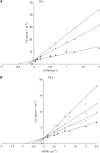[18F]FDG and [18F]FLT uptake in human breast cancer cells in relation to the effects of chemotherapy: an in vitro study
- PMID: 18665170
- PMCID: PMC2527810
- DOI: 10.1038/sj.bjc.6604523
[18F]FDG and [18F]FLT uptake in human breast cancer cells in relation to the effects of chemotherapy: an in vitro study
Abstract
Increased 2'-deoxy-2'-[18F]fluoro-D-glucose (FDG) uptake is the most commonly used marker for positron emission tomography in oncology. However, a proliferation tracer such as 3'-deoxy-3'-[18F]fluorothymidine (FLT) might be more specific for cancer. 3'-deoxy-3'-[18F]fluorothymidine uptake is dependent on thymidine kinase 1 (TK) activity, but the effects of chemotherapeutic agents are unknown. The aim of this study was to characterise FDG and FLT uptake mechanisms in vitro before and after exposure to chemotherapeutic agents. The effects of 5-fluorouracil (5-FU), doxorubicin and paclitaxel on FDG and FLT uptake were measured in MDA MB231 human breast cancer cells in relation to cell cycle distribution, expression and enzyme activity of TK-1. At IC50 concentrations, 5-FU resulted in accumulation in the G1 phase, but doxorubicin and paclitaxel induced a G2/M accumulation. Compared with untreated cells, 5-FU and doxorubicin increased TK-1 levels by >300. At 72 h, 5-FU decreased FDG uptake by 50% and FLT uptake by 54%, whereas doxorubicin increased FDG and FLT uptake by 71 and 173%, respectively. Paclitaxel increased FDG uptake with >100% after 48 h, whereas FLT uptake hardly changed. In conclusion, various chemotherapeutic agents, commonly used in the treatment of breast cancer, have different effects on the time course of uptake of both FDG and FLT in vitro. This might have implications for interpretation of clinical findings.
Figures

 ), doxorubicin (
), doxorubicin ( ), paclitaxel (▪) and untreated cells (□), in (A) sub-G1, (B) G1, (C) S and (D) G2/M phases.
), paclitaxel (▪) and untreated cells (□), in (A) sub-G1, (B) G1, (C) S and (D) G2/M phases.
 ), doxorubicin (
), doxorubicin ( ) and paclitaxel (▪), and compared with untreated cells (□).
) and paclitaxel (▪), and compared with untreated cells (□).
 ), doxorubicin (
), doxorubicin ( ) and paclitaxel (▪), and compared with untreated cells (□). % cells are normalised to TK activity before addition of dCTP or KIN52 (set to 100%).
) and paclitaxel (▪), and compared with untreated cells (□). % cells are normalised to TK activity before addition of dCTP or KIN52 (set to 100%).

Similar articles
-
Phosphorylation status of thymidine kinase 1 following antiproliferative drug treatment mediates 3'-deoxy-3'-[18F]-fluorothymidine cellular retention.PLoS One. 2014 Jul 8;9(7):e101366. doi: 10.1371/journal.pone.0101366. eCollection 2014. PLoS One. 2014. PMID: 25003822 Free PMC article.
-
3'-deoxy-3'-[18F]fluorothymidine as a new marker for monitoring tumor response to antiproliferative therapy in vivo with positron emission tomography.Cancer Res. 2003 Jul 1;63(13):3791-8. Cancer Res. 2003. PMID: 12839975
-
3'-Deoxy-3'-[(18)F]fluorothymidine (FLT) uptake in breast cancer cells as a measure of proliferation after doxorubicin and docetaxel treatment.Nucl Med Biol. 2009 Feb;36(2):163-9. doi: 10.1016/j.nucmedbio.2008.10.012. Nucl Med Biol. 2009. PMID: 19217528
-
3'-Deoxy-3'-[18F]fluorothymidine.2004 Oct 1 [updated 2005 Jan 15]. In: Molecular Imaging and Contrast Agent Database (MICAD) [Internet]. Bethesda (MD): National Center for Biotechnology Information (US); 2004–2013. 2004 Oct 1 [updated 2005 Jan 15]. In: Molecular Imaging and Contrast Agent Database (MICAD) [Internet]. Bethesda (MD): National Center for Biotechnology Information (US); 2004–2013. PMID: 20641574 Free Books & Documents. Review.
-
[Is 3'-deoxy-3'- [18F] fluorothymidine ([18F]-FLT) the next tracer for routine clinical PET after R [18F]-FDG?].Bull Cancer. 2005 Sep;92(9):789-98. Bull Cancer. 2005. PMID: 16203269 Review. French.
Cited by
-
Evaluation of FLT-PET-CT as an imaging biomarker of proliferation in primary breast cancer.Br J Cancer. 2014 Jun 10;110(12):2847-54. doi: 10.1038/bjc.2014.207. Epub 2014 May 15. Br J Cancer. 2014. PMID: 24832174 Free PMC article.
-
Dynamic PET evaluation of elevated FLT level after sorafenib treatment in mice bearing human renal cell carcinoma xenograft.EJNMMI Res. 2016 Dec;6(1):90. doi: 10.1186/s13550-016-0246-z. Epub 2016 Dec 12. EJNMMI Res. 2016. PMID: 27957722 Free PMC article.
-
Synthesis of [18F]F-γ-T-3, a Redox-Silent γ-Tocotrienol (γ-T-3) Vitamin E Analogue for Image-Based In Vivo Studies of Vitamin E Biodistribution and Dynamics.Molecules. 2020 Dec 3;25(23):5700. doi: 10.3390/molecules25235700. Molecules. 2020. PMID: 33287202 Free PMC article.
-
Early assessment of tumor response to JAC106, an anti-tubulin agent, by 3'-deoxy-3'-[¹⁸F]fluorothymidine in preclinical tumor models.Eur J Nucl Med Mol Imaging. 2011 Aug;38(8):1436-48. doi: 10.1007/s00259-011-1802-4. Epub 2011 Apr 12. Eur J Nucl Med Mol Imaging. 2011. PMID: 21484374
-
Prospective comparison of early interim 18F-FDG-PET with 18F-FLT-PET for predicting treatment response and survival in metastatic breast cancer.BMC Cancer. 2021 Aug 10;21(1):908. doi: 10.1186/s12885-021-08649-z. BMC Cancer. 2021. PMID: 34376155 Free PMC article.
References
-
- Ackland SP, Clarke SJ, Beale P, Peters GJ (2002) Thymidylate synthase inhibitors. Cancer Chemother Biol Response Modif 20: 1–36 - PubMed
-
- Balzarini J, Hernandez AI, Roche P, Esnouf R, Karlsson A, Camarasa MJ, Perez-Perez MJ (2003) Non-nucleoside inhibitors of mitochondrial thymidine kinase (TK-2) differentially inhibit the closely related herpes simplex virus type 1 TK and Drosophila melanogaster multifunctional deoxynucleoside kinase. Mol Pharmacol 63: 263–270 - PubMed
-
- Barthel H, Cleij MC, Collingridge DR, Hutchinson OC, Osman S, He Q, Luthra SK, Brady F, Price PM, Aboagye EO (2003) 3′-deoxy-3′-[18F]fluorothymidine as a new marker for monitoring tumor response to antiproliferative therapy in vivo with positron emission tomography. Cancer Res 63: 3791–3798 - PubMed
-
- Barthel H, Perumal M, Latigo J, He Q, Brady F, Luthra SK, Price PM, Aboagye EO (2005) The uptake of 3′-deoxy-3′-[18F]fluorothymidine into L5178Y tumours in vivo is dependent on thymidine kinase 1 protein levels. Eur J Nucl Med Mol Imaging 32: 257–263 - PubMed
-
- Chang ZF, Huang DY, Hsue NC (1994) Differential phosphorylation of human thymidine kinase in proliferating and M phase-arrested human cells. J Biol Chem 269: 21249–21254 - PubMed
Publication types
MeSH terms
Substances
LinkOut - more resources
Full Text Sources
Medical

